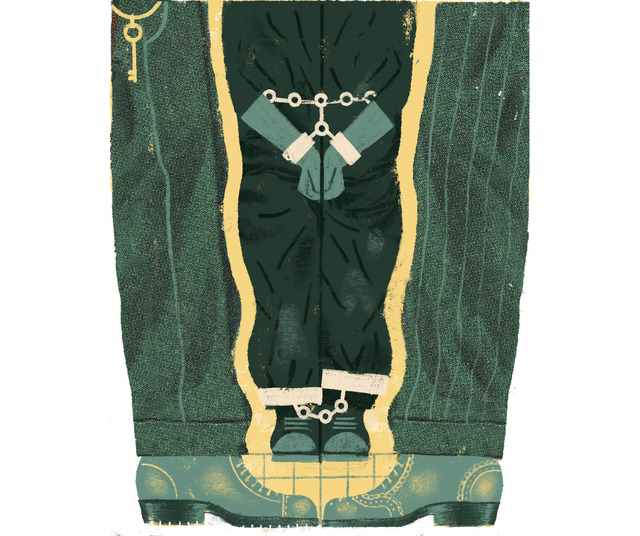The Local newsletter is your free, daily guide to life in Colorado. For locals, by locals.
A clinking sound accompanied Sean Taylor down the hallway of the Denver County Courthouse. The leg irons that bound the teenager’s ankles made it difficult to walk as he shuffled his feet along the corridor. The chain around his abdomen rattled as he tried to adjust the attached handcuffs so they’d stop scraping against his wrists. Taylor’s mother slowed her steps to stay beside her son.
The restraints were heavy and uncomfortable, and Taylor carried their weight—20 pounds or so—somberly. Three days after his 17th birthday, in September 1989, he’d been charged with first-degree murder for killing another 17-year-old. Taylor had been trying to show off for his fellow Bloods when he’d pointed a gun at a rival gang member’s house—intending, he says, to cause property damage. But the bullet struck and killed a young man who happened to be on the other side of the closed front door.
In the courtroom, Taylor leaned down to tuck his pants into the ankle restraints in an attempt to separate the cold metal from bruises caused by the shackles. His brown eyes took in the room and eventually settled on his mother. He was distressed that she had to witness her son in restraints. Once, Taylor’s mother approached a sheriff’s deputy to ask whether her son really needed to be held in chains. “He’s not going to run,” she told the man. “He turned himself in.” The deputy said the shackles had to stay.
Twenty-seven years later, Taylor still remembers how it felt to stand, cuffed, in that courtroom. “The shackles dehumanize you,” he says. “They make you feel like even though you’re supposed to be in a court that’s fair, it feels unfair because you’re the only one in there with a belly chain, shackles, and handcuffs on. You’re the only animal who needs to be chained down.”
When it comes to adults, legal precedent is fairly clear: Those accused of criminal offenses are not routinely forced to wear visible restraints in a courtroom unless a “special need” is present. To treat defendants otherwise is considered prejudicial. There are, however, no federal guidelines when it comes to children.
No one can say for sure how Colorado ended up with an unofficial policy of walking kids into courtrooms in shackles, but during the past three decades, an increasing number of minors being held in custody in the state—and in many places across the country—have entered courts in restraints. “I don’t know when we started chaining up kids like animals,” says Ann Roan, the state training director for juvenile defense and complex litigation at the Office of the Colorado State Public Defender. “Ever since [Denver’s] Summer of Violence [in 1993], there has been a perception that children involved in the juvenile justice system are, without exception, incredibly dangerous.”
Slowly, though, people have started to recognize the impacts of this practice. Researchers have published papers on how shackling erodes juveniles’ perceptions of fairness in our justice system; how it can be a traumatizing experience with long-lasting impacts on their brains and identities; and how the discomfort of shackles can impact their abilities to focus in court, take part in their own defense, and communicate adequately with their counsel. “Shackling a child and then turning around and telling that child ‘we presume you innocent’ is a contradiction in terms that every child can see for the fiction that it is,” Roan says.
But the concerns extend beyond the science. Corrections data show that children of color and lower socioeconomic status are more likely to be held in custody, which means they’re also shackled more often. On top of that, advocates argue, placing children in chains undermines the rehabilitative purpose of juvenile court. And they contend that indiscriminate shackling doesn’t take into account an individual’s behavior, history of abuse or trauma, or what crime he or she has been accused of. A kid who stole a candy bar and one convicted of assault can both appear in court the same way.
Since 2007, 27 states and Washington, D.C., have adopted legislation or statewide court rules that limit the use of restraints on juveniles to special circumstances, determined on a case-by-case basis by a judge upon request by either the defense or prosecution. Those exceptions include a minor who has a credible escape plan or one who recently attempted to attack an officer, but even in those cases shackling is only a last resort. The authors of a 2008 study published in the UC Davis Journal of Juvenile Law & Policy wrote: “These legislative enactments effectively shift the burden from the juvenile to the bench to establish the necessity for physically restraining a child…. The shift in this burden is an affirmation of juvenile rights and marks the beginning of an important and crucial change in the treatment of juvenile offenders.”
That shift has yet to reach Colorado. State representatives attempted to pass anti-shackling legislation during the past two sessions. The most recent bill, introduced in March, would have created a statewide mandate against shackling. Both bills failed along party lines (Democrats in support, Republicans against). Instead, Colorado has 22 separate policies, developed independently by each judicial district, that were created in response to a 2015 directive from Chief Justice Nancy Rice of the state Supreme Court.
The incongruent guidelines mean youth are treated differently in each court and at every hearing. Take, for example, the First Judicial District (Jefferson and Gilpin counties); there, the majority of youth are unshackled. But in the 18th, which includes Littleton and Castle Rock, almost all kids wear handcuffs attached to belly chains. And in the Fourth Judicial District (El Paso and Teller counties), juveniles appear in court via video conferencing to avoid the shackling question altogether.
Advocates like Roan say this “patchwork quilt of inconsistent approaches” is exactly what they’d hoped to avoid with a statewide approach. “In many of the policies, there are so many exceptions, or the exceptions are so broad,” she says, “that they end up defeating the presumption [against shackling] altogether.” Yet those working in juvenile justice do see progress. “I don’t think any child advocate thinks it’s gone far enough,” says Chris Henderson with Child Advocates of Colorado. “But it is nice to see some kids coming in unshackled.”
Law enforcement officials are the most outspoken opponents of local proposals to end indiscriminate shackling. Sheriff’s departments have argued against creating a single statewide policy because, they say, every courthouse—and thus every safety plan—is different, and many units don’t have the money to hire additional personnel to keep watch over unshackled kids. “You can’t have a tailored approach that is workable for every county,” says Chris Johnson, executive director of the County Sheriffs of Colorado. “The sheriffs, in conjunction with the courts, are the best ones to make a determination on whether a juvenile should be shackled in court.” Recent legislative and advocacy efforts also often don’t address the transportation of juveniles to the courthouse; in Colorado, kids can be shackled during trips to and from detention and court.
Judges, though, have final say over their courtrooms. The majority of juvenile cases in the state are presented in front of judges—jury trials are only called for in specific situations—but advocates say even these impartial arbiters can’t escape the implicit bias that may creep up as a result of seeing children in handcuffs or leg irons day after day. “There’s a lost sense of fairness and procedural justice that impacts that youth, as well as the physical and mental trauma of being shackled,” says Christina Gilbert, staff attorney and policy counsel at the National Juvenile Defender Center and campaign manager of its two-year-old Campaign Against Indiscriminate Juvenile Shackling. Several national organizations agree: Last year, the American Bar Association, National Council of Juvenile and Family Court Judges, Child Welfare League of America, and American Academy of Child and Adolescent Psychiatry, among others, all formalized official positions against shackling.
In Colorado, Boulder County was the first judicial district to stop shackling kids, ending the practice in January 2014. The district’s new policy—“No juvenile shall be restrained indiscriminately”—is one of the only measures in the state that doesn’t include a list of exceptions (though four specific criteria are in place that could permit a judge to order a youth to be shackled). Before 2014, juveniles in Boulder wore full restraints at every hearing. In 2015, 522 youth appeared in court, and only two of them were shackled in any way. The sheriff’s department hired two additional deputies to transport and oversee the minors at a cost of about $135,000 per year.
Since the new policy took effect, there have been zero incidents in the courtroom. “Everything is going really well,” says Carole Greenwell, program manager for the Boulder County Juvenile Assessment Center. “The biggest thing was just finding a good balance between doing what was best for the kid and public safety at the same time.” (Miami-Dade County in Florida has seen more than 30,000 youth appear in court since the area stopped shackling in 2006; as in Boulder, not a single youth has escaped or caused a disturbance in the courtroom.)
Beyond the numbers, the question remains as to why we ever started shackling children in the first place. “We’ve certainly figured out how to make courtrooms safe for adults,” Henderson says. Why, he and others wonder, aren’t youth like Taylor afforded equal protections? (Taylor was released from prison on parole in 2011.) “Kids in the juvenile justice system don’t go away—they turn into adults,” Roan says. “So we all have a vested interest in making sure they grow up to be productive, engaged members of our community. And the way to do that isn’t by shackling them.”









